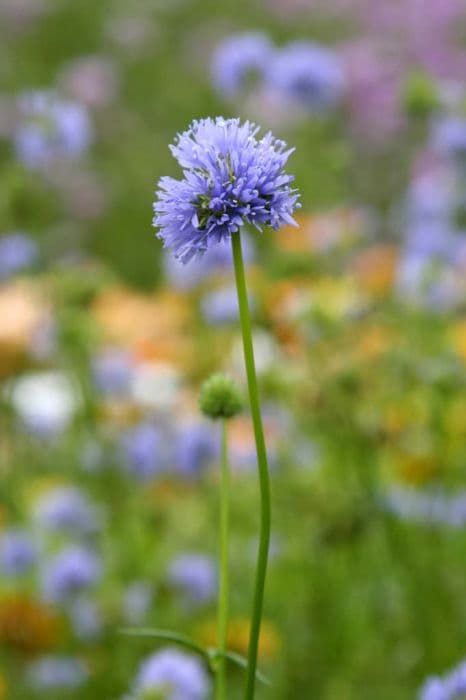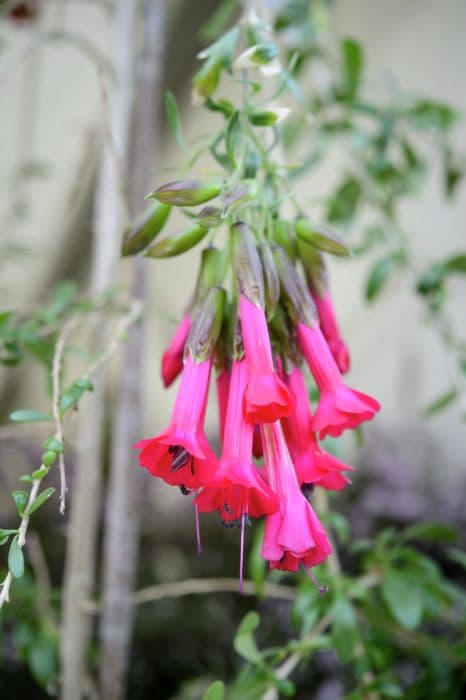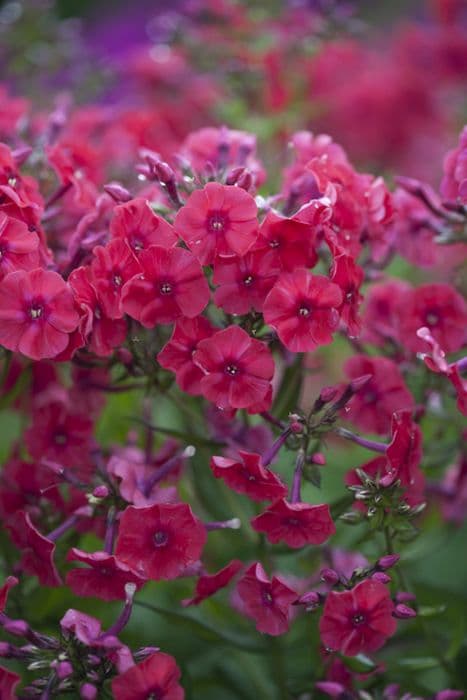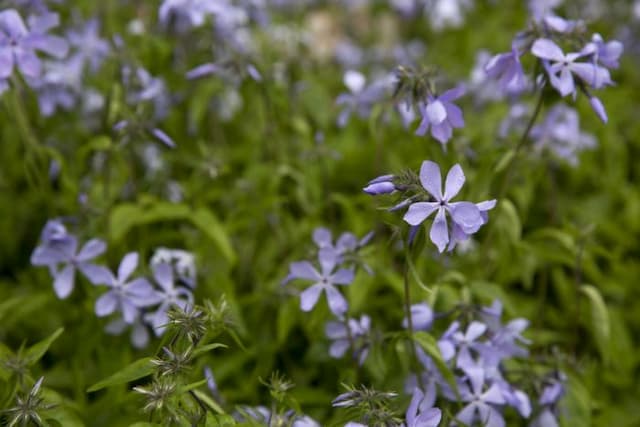Garden Phlox Phlox paniculata 'Eva Cullum'

ABOUT
The garden phlox 'Eva Cullum' is renowned for its showy and colorful flowers. These blooms can typically be described as clusters of vivid pink flowers that possess a contrasting eye of a darker hue. Their petals are slightly rounded with a soft appearance, often with a gentle overlapping at their edges, contributing to their lush, full look. The clusters, known as panicles, assemble at the top of sturdy, upright stems which are adorned with bright green, lance-shaped leaves that provide a delicate contrast to the vibrant flowers. The leaves are typically pointed at the tips and can vary in size but generally have a smooth texture. With its striking floral display, this garden phlox variety adds a splash of color to any garden setting, attracting both visual interest as well as pollinators such as butterflies and hummingbirds.
About this plant
 Names
NamesFamily
Polemoniaceae
Synonyms
Garden Phlox, Summer Phlox, Perennial Phlox, Fall Phlox
Common names
Phlox paniculata 'Eva Cullum'.
 Toxicity
ToxicityTo humans
Garden Phlox is generally not considered toxic to humans. However, as with any non-edible plant, there could be individual cases of sensitivity or allergic reaction if ingested or if a person comes into contact with the plant. Ingesting any part of a non-edible plant can cause gastrointestinal discomfort, nausea, vomiting, and diarrhea in some individuals.
To pets
Garden Phlox is also generally considered non-toxic to pets. That said, animals may experience mild gastrointestinal discomfort if they consume significant quantities of the plant. Symptoms could include vomiting or diarrhea. It is always a good practice to prevent pets from ingesting plants that are not meant for consumption.
 Characteristics
CharacteristicsLife cycle
Perennials
Foliage type
Deciduous
Color of leaves
Green
Flower color
Pink
Height
2-4 feet (0.6-1.2 meters)
Spread
1-3 feet (0.3-0.9 meters)
Plant type
Herb
Hardiness zones
4-8
Native area
North America
Benefits
 General Benefits
General Benefits- Aesthetic Appeal: 'Eva Cullum' produces vibrant pink blooms with a darker eye, adding a splash of color to any garden.
- Attracts Pollinators: The flowers are a nectar source for butterflies and hummingbirds, promoting biodiversity.
- Fragrance: The plant is known for its sweet scent, which can enhance the sensory experience of a garden.
- Long Blooming Period: It flowers from mid-summer to early fall, providing extended visual interest.
- Drought Tolerance: Once established, it has a good level of drought tolerance, reducing the need for frequent watering.
- Easy to Grow: Phlox paniculata 'Eva Cullum' is relatively easy to care for, making it suitable for beginner gardeners.
- Cut Flower Use: The blooms hold up well in vases, making them excellent for fresh floral arrangements.
- Perennial Growth: As a perennial, it will return each year, giving long-term value to the garden space.
- Deer Resistance: It is not a preferred food source for deer, which can help prevent damage to the garden.
- Versatility: Suitable for borders, cottage gardens, and as part of perennial beds, offering multiple landscaping options.
 Medical Properties
Medical PropertiesThis plant is not used for medical purposes.
 Air-purifying Qualities
Air-purifying QualitiesThis plant is not specifically known for air purifying qualities.
 Other Uses
Other Uses- Garden Sleep Aid: Dried flowers of garden phlox can be stuffed in cloth bags and placed under pillows to encourage restful sleep through their gentle, soothing fragrance.
- Natural Dye: The petals of garden phlox can be used to create a natural pink dye for textiles and art projects.
- Creative Pressed Flower Art: Fresh garden phlox flowers can be pressed and used in crafting unique bookmarks, greeting cards, or framed botanical art.
- Photography Prop: Garden phlox, with its vivid flowers, serves as a stunning prop for photographers looking to add a splash of color to their compositions.
- Scented Sachets: Dried garden phlox flowers can be sewn into small sachets and placed in drawers or closets to impart a pleasant aroma to clothes and linens.
- Garden Design: Due to its height and volume, garden phlox can be used in garden designs to create visual depth or as a natural fence for privacy.
- Decorative Table Settings: Fresh garden phlox flowers can embellish table settings for special occasions or add a touch of elegance to any dining experience.
- Butterfly Gardens: Garden phlox can be included in butterfly gardens to attract and support these pollinators, enhancing the ecological value of any outdoor space.
- Educational Tool: Educators can use garden phlox to illustrate topics in botany and ecology, such as plant life cycles, pollination, and garden ecosystems.
- Homemade Potpourri: A mixture of dried garden phlox petals, spices, and essential oils can create a fragrant, homemade potpourri.
Interesting Facts
 Feng Shui
Feng ShuiThe Garden Phlox is not used in Feng Shui practice.
 Zodiac Sign Compitability
Zodiac Sign CompitabilityThe Garden Phlox is not used in astrology practice.
 Plant Symbolism
Plant Symbolism- Unity and Harmony: Phlox paniculata 'Eva Cullum', commonly known as Garden Phlox, often symbolizes unity and harmony, representing the blending of different individuals into a peaceful whole.
- Proposal and Romance: Due to its colorful and attractive flowers, Garden Phlox can also symbolize a proposal or an expression of romantic feelings.
- Agreement: The harmonious appearance of its clustered flowers can symbolize agreement or consensus within a group.
- Sweet Dreams: In some cultures, Garden Phlox is associated with sweet dreams and is believed to bring about pleasant and tranquil sleep.
 Water
WaterGarden Phlox should be watered deeply once a week, allowing the soil to dry out between watering sessions. In periods of extreme heat or drought, watering frequency should increase to every 3 to 4 days. When watering, avoid overhead watering to prevent mildew and rather water at the base of the plant, using about one gallon of water per plant for each watering session.
 Light
LightGarden Phlox thrives in full sun but can tolerate partial shade. The best spot for this plant is an area that receives at least six hours of direct sunlight daily. Avoid too much shade as it can lead to poor flowering and an increased risk of disease.
 Temperature
TemperatureGarden Phlox prefers a temperature range between 60°F and 80°F. It can survive minimum temperatures down to about -30°F once established. Ideal growth occurs when night temperatures are slightly cooler than during the day, providing a gentle contrast that promotes healthy blooms.
 Pruning
PruningPruning Garden Phlox is necessary to encourage bushier growth and more blooms. Deadhead spent flowers regularly to prolong the blooming period. A more thorough pruning should be done in early spring or late winter, cutting back the plant to about one to two feet to maintain its shape and health. Additionally, after the first killing frost, prune back the stems to within a few inches of the ground.
 Cleaning
CleaningAs needed
 Soil
SoilGarden Phlox prefers rich, moist, well-draining soil with a pH range of 6.0 to 8.0. A good soil mix would consist of garden soil, compost, and perlite to ensure adequate drainage and fertility.
 Repotting
RepottingGarden Phlox, being a perennial garden flower, doesn't typically require repotting as it is not usually grown in containers.
 Humidity & Misting
Humidity & MistingGarden Phlox thrives in average outdoor humidity levels; it doesn't require any special humidity conditions.
 Suitable locations
Suitable locationsIndoor
Ensure bright light, good air flow, and moist, well-drained soil.
Outdoor
Plant in sun or part shade, in fertile, moist soil.
Hardiness zone
4-8 USDA
 Life cycle
Life cyclePhlox paniculata 'Eva Cullum', commonly known as Garden Phlox, begins its life cycle as a dormant seed, waiting for the ideal conditions of warmth and moisture to germinate in late spring. Once germinated, the seedling emerges and develops into a young plant with a rosette of leaves at the soil level. As the Garden Phlox matures, it produces sturdy stems and lush foliage throughout the growing season, typically reaching its full height by midsummer. During summer, it enters the flowering stage, producing clusters of fragrant, pink flowers that attract pollinators like butterflies and hummingbirds. After blooming, the plant sets seed in late summer or fall; these seeds may drop to the ground and enter a period of dormancy before the cycle begins again or be collected for propagation. In winter, Garden Phlox dies back to the ground, with its root system remaining alive to regenerate the next spring.
 Propogation
PropogationPropogation time
Spring-Summer
Propogation: Garden Phlox, or Phlox paniculata 'Eva Cullum', is best propagated in the spring or early summer. The most popular method for propagating this perennial is by division. This process involves carefully digging up an established clump of phlox and gently separating it into smaller sections. Each section should have a good amount of roots and a few shoots. These divisions can then be replanted in a well-prepared soil that's rich in organic matter. Water the new plants thoroughly after planting to help establish them. It's a straightforward technique that allows gardeners to quickly multiply their phlox plants while ensuring the new plants will be true to the parent in terms of their characteristics.









